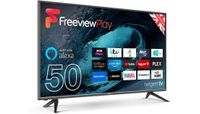Should I buy a Cello TV? A look at the British TV brand

If you’ve been thinking about buying a new TV with a more humble price tag, Cello TVs may well have come up in your search. Rather than selling through the supermarkets like a lot of affordable TV manufacturers, this British brand tends to stock with popular online retailers like Amazon and eBay, and is also sold through mail order catalogues like Freemans, Grattan and JD Williams.
However, that does mean that you might not have heard a lot about them, so we’ve pulled together this guide to the Cello TV brand, along with details on the most recent models we’ve tested and how much money you should look to spend on them.
With a British-made boast that no other LED TV manufacturer can claim, Cello manufactures all of its TVs in the North East of England, at its factory in County Durham. It currently produces sets from 16-inch up to 50-inch, and offers 4K as well as Full HD and 720p resolutions to suit all budgets and requirements.
Cello was first established in 2001, and has had a focus on TVs since 2005 – not quite the legacy of some decades-old TV brands, but it’s not a newbie either.
This year the company launched its new range of Android smart TVs complete with Chromecast support, and also began manufacturing TVs under the Ferguson brand for the UK market as well.
Our focus here is on those marketed under the Cello brand though, so If you’re intrigued to see how they stack up against the competition and whether they’re worth investing in, read on for everything you need to know.
Should I buy a Cello TV?
Cello makes a big selling point out of its British heritage, promising high production standards and stringent quality checks at every step. It also promises an industry-leading after-care service, including technical support, for absolute peace of mind when buying.
Sign up for breaking news, reviews, opinion, top tech deals, and more.
Considering much of its budget competition is manufactured abroad, many of Cello’s potential customers will likely feel some reassurance with the ability to speak directly with the manufacturer, in their own time zone, with any issues or concerns.
For this reason, it is a popular manufacturer with older customers, though of course it is bought by people of all ages.
The performance of Cello TVs can’t compete with the more expensive brands, but it isn’t supposed to. We’ve generally found Cello TVs to offer a middling performance at a pretty appropriate price. You won’t feel like you’re getting a bargain, but shouldn’t feel ripped off either.
It’s fair to say that Cello TVs aren’t going to blow you away if your focus is on performance alone, but the balance of affordability and peace of mind may well give you cause to consider them, especially if the more unique features offered by Cello appeal.

Cello TV features and formats
Cello’s range aims to offer a TV for everyone, but tends to focus on areas that more mainstream manufacturers are leaving behind.
That means it currently only offers a single 4K TV for those who want it, with the majority of its range made up of Full HD and 720p sets – a largely underserved market in an age of 4K and 8K TVs.
Freeview Play is found on Cello TVs as standard – something you won’t find on new Samsung TVs, for one – along with Amazon Alexa integration and Android TV smarts. There are also some quirky options, like battery-powered TVs and TVs with built-in DVD players, to really help it stand out from the crowd.
That means if you’re looking for the latest and greatest technology or the very best in picture performance, Cello isn’t going to tick your boxes. Its only 4K TV currently on sale, the C5020DVB4K, doesn’t even offer HDR support, and while HDR is usually pretty poor on budget TVs, to not offer it at all feels like a bit of an oversight.
Things that you’re also likely to miss out on at this price are screen brightness, the wider colour gamut than you’d see on pricier sets, and advanced processing. Cello’s smart TV system has also been a bit of a disaster in TVs we’ve tested previously, but hopefully the introduction of Android TV in its more recent sets – as used by the likes of Sony and Philips – should help to improve that.
This most recent range goes from a 24-inch 720p set at about £165 to a 50-inch full HD option at £330, and if you’re keen on the added functionality of a smart TV, we would definitely suggest you consider one of these. They’ll offer you popular apps like Netflix, Prime Video, Disney Plus and most UK catch-up TV apps via Freeview Play, which is not bad at all.
You could go for one of the brand’s Freeview Play-only sets, but they make do with Cello’s own smart TV system, which we found left a fair bit to be desired on the Cello Netgem TV.
Be aware that your choice of Cello TV will be determined by where you shop. The full range is listed as available on Amazon, eBay and TV Village, with smaller ranges stocked elsewhere. To browse what’s available in full, we’d recommend checking out Cello’s website directly for the most up to date details.

Cello TV reviews
Now you’re in the know about Cello as a brand, it’s time to see how it’s fared in our reviews.
We’ve tested a few sets over the years, at different sizes and budgets, but have picked out our most recent for you here. We’ll keep adding to this the more Cello TVs that we get in for testing, so you know where — if anywhere — your cash is best spent.

Cello Netgem smart TV
A very capable HD TV that’s seriously affordable. No, there’s no 4K resolution, HDR or the company’s most recent Android smart TV system, and the Alexa integration is far from perfect too. But if price is your number one priority it’s very much worth considering.

Cello P50ANSMT
A 4K TV with some considerable shortcomings. While the picture is sharp and relatively detailed at this price, its colours, brightness and upscaling aren’t anything to write home about, and the lack of HDR is frustrating too.

Cello P32ANSMT
For its price, this is actually a very watchable TV indeed. There are limitations due to its low cost, of course, but it’s actually the promise of its built-in soundbar and smart TV system that lets it down, as these let it down.
- Smart TV prices: new TVs for any budget

Verity is a freelance technology journalist, with previous on-staff roles at What Hi-Fi?, Stuff, Pocket-lint and MSN.
Having chalked up more than 15 years in the industry, she has covered the highs and lows across the breadth of consumer tech, sometimes travelling to the other side of the world to do so. With a specialism in audio and TV, however, it means she's managed to spend a lot of time watching films and listening to music in the name of "work".
You'll occasionally catch her on BBC Radio commenting on the latest tech news stories, and always find her in the living room, tweaking terrible TV settings at parties.